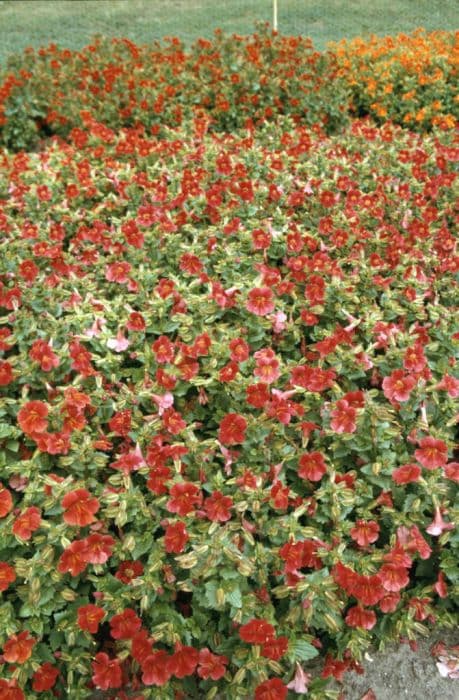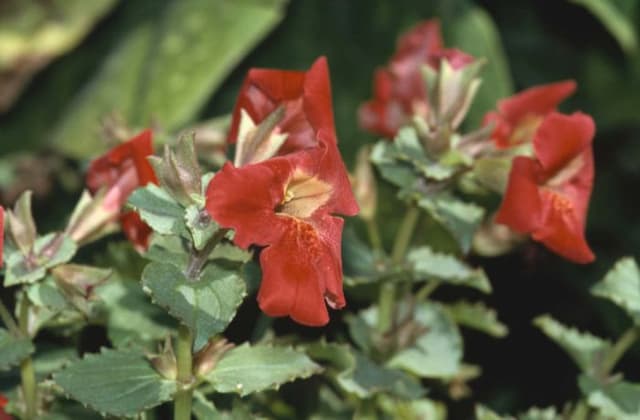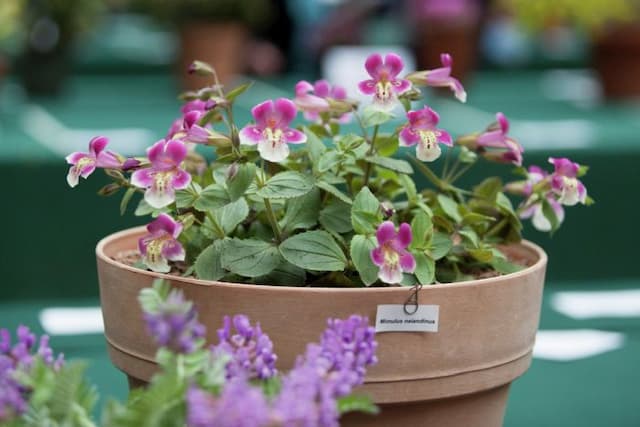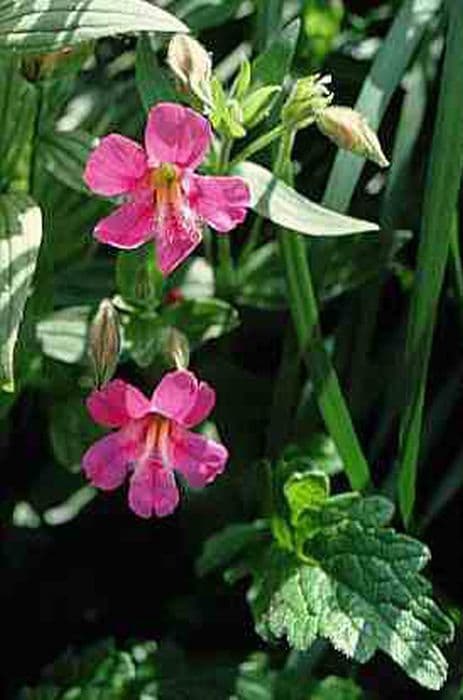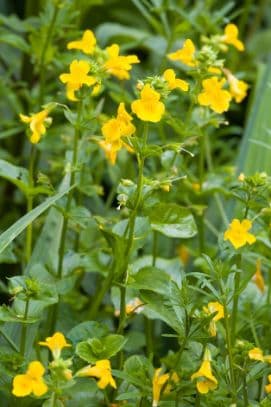Monkey Flower Mimulus luteus

ABOUT
The yellow monkey flower, known as Mimulus luteus, is a vibrant herbaceous plant that is particularly recognized for its attractive blossoms. The flowers of this species are distinctly trumpet-shaped and are a vivid shade of yellow, often sporting some brownish or reddish spots within the throat of the bloom—a pattern that enhances their visual appeal and is thought to aid in attracting pollinators. The leaves of the yellow monkey flower are generally green, and these foliage parts can vary in shape. They are often found to be either ovate or lanceolate depending on the maturity of the leaf, with a slightly serrated margin that provides a delicate texture to the overall appearance of the plant. The leaf arrangement can be opposite, where pairs of leaves emerge from the same position on the stem, or sometimes alternately arranged, where leaves are spaced alternately along the stem. The stems of the yellow monkey flower are known for their flexible and erect habit, branching out to support the weight of the leaves and flowers. They carry a soft, fresh green color that complements the yellow blooms. Together, the cheerful yellow flowers, lush green leaves, and erect stems create a lively visual display commonly found near streams, wetlands, or in gardens where the plant is cultivated for its ornamental value. It's the allure of the trumpet-shaped yellow blossoms that make the yellow monkey flower a popular choice for adding a splash of color to natural settings and cultivated landscapes.
About this plant
 Names
NamesFamily
Phrymaceae
Synonyms
Yellow Monkeyflower, Blood-drop Emlets, Monkey Musk
Common names
Erythranthe lutea, Mimulus cupreus, Mimulus gracilis, Mimulus langsdorffii var. luteus, Mimulus luteus var. macrophyllus, Mimulus luteus var. variegatus
 Toxicity
ToxicityTo humans
Mimulus luteus, commonly known as Yellow Monkeyflower, is not commonly recognized as a poisonous plant to humans. There is a lack of significant evidence suggesting that it has toxic properties that cause harm when touched or ingested. Consequently, there is no well-documented list of symptoms associated with Yellow Monkeyflower poisoning in humans. Still, as with any plant, individuals could potentially have allergic reactions or sensitivity, so it is advisable to exercise caution and avoid ingesting plants that are not known to be edible.
To pets
Yellow Monkeyflower (Mimulus luteus) is not commonly listed as a toxic plant to pets such as dogs and cats. There is little information suggesting that the Yellow Monkeyflower presents toxicity issues for household pets. Therefore, there are no specific symptoms that are known to arise from pets ingesting this plant. However, it is generally prudent to prevent pets from consuming plants not intended for their diet, as individual animals might have unexpected reactions or sensitivities.
 Characteristics
CharacteristicsLife cycle
Perennials
Foliage type
Deciduous
Color of leaves
Green
Flower color
Yellow
Height
2 feet (0.6 meters)
Spread
2 feet (0.6 meters)
Plant type
Herb
Hardiness zones
9
Native area
South America
Benefits
 General Benefits
General Benefits- Aesthetically Appealing - Mimulus luteus, commonly known as Monkey Flower, has vibrant yellow, trumpet-shaped flowers that enhance garden beauty.
- Pollinator Attraction - It attracts bees, butterflies, and other important pollinators that contribute to the health of the ecosystem.
- Drought Tolerance - Monkey Flower is relatively drought-resistant once established, making it suitable for xeriscaping and low-water gardens.
- Erosion Control - Its growth habit can help stabilize soil in areas prone to erosion.
- Habitat Restoration - It is sometimes used in wildland restoration projects where its native presence can support local biodiversity.
 Medical Properties
Medical PropertiesThis plant is not used for medical purposes.
 Air-purifying Qualities
Air-purifying QualitiesThis plant is not specifically known for air purifying qualities.
 Other Uses
Other Uses- Mimulus luteus, also known as Monkey Flower, can act as a model organism for genetic studies due to its complex genetic structure and its ability to hybridize with closely related species.
- In educational settings, Monkey Flower is used to demonstrate plant reproduction and pollination processes due to its conspicuous flowers that attract pollinators.
- The showy blossoms of Mimulus luteus can be used in floral arrangements and ornamental displays, providing a bright splash of color.
- As a ground cover plant, Monkey Flower can be used to stabilize soil in erosion-prone areas thanks to its extensive root system.
- Mimulus luteus can serve as an indicator species in ecological studies, helping scientists assess the health of an ecosystem or the impact of environmental changes.
- In garden ponds or water features, the Monkey Flower can be planted to provide shelter and breeding grounds for aquatic wildlife, such as frogs and beneficial insects.
- The plant's ability to grow in wet conditions makes Monkey Flower useful for phytoremediation, where it can help remove toxins from waterlogged soils.
- Gardeners who specialize in xeriscaping use Monkey Flower because of its ability to withstand periods of drought once established.
- Mimulus luteus seeds can be used for educational workshops on seed-saving techniques, due to their ease of collection and handling.
- Traditional landscapers sometimes use Monkey Flower as a companion plant to create aesthetically pleasing and ecologically balanced garden designs.
Interesting Facts
 Feng Shui
Feng ShuiThe Yellow Monkeyflower is not used in Feng Shui practice.
 Zodiac Sign Compitability
Zodiac Sign CompitabilityThe Yellow Monkeyflower is not used in astrology practice.
 Plant Symbolism
Plant Symbolism- Courage: Mimulus luteus, commonly known as Monkey Flower, is often associated with courage due to its bright and bold colors, symbolizing the ability to face challenges with bravery.
- Fearlessness: The Monkey Flower symbolizes fearlessness, as it can grow in challenging environments and represents overcoming fears and anxieties.
- Positive Energy: Its vibrant flowers are thought to bring positive energy and are often used to uplift spirits and encourage a cheerful disposition.
- Playfulness: The playful appearance of the Monkey Flower, with its unique shape that resembles a monkey's face, is indicative of playfulness and a reminder not to take life too seriously.
 Water
WaterThe Monkey Flower prefers consistent moisture and should be watered deeply once the top inch of soil starts to dry out, typically once a week, depending on the climate and weather conditions. It's crucial not to let the plant sit in waterlogged soil to prevent root rot. In general, a good approach is to provide the Monkey Flower with about 1 gallon of water every 7 days, adjusting as needed for rainfall and temperature changes, and during the hot summer months, the frequency may increase to maintain moist soil conditions.
 Light
LightMonkey Flower thrives best in full sun to partial shade conditions. The ideal spot for this plant would be an area that receives morning sunlight and partial shade in the afternoon, especially in regions with very hot summers. Ensuring that it gets at least 6 hours of sunlight per day will promote optimal growth and flowering.
 Temperature
TemperatureMonkey Flower is adaptable to a range of temperatures but performs best when daytime temperatures are between 60 to 75 degrees Fahrenheit. It can tolerate a minimum temperature of around 20 degrees Fahrenheit, but frost and freezing conditions should be avoided to prevent damage. Ideally, keep this plant in a location where temperatures stay within this range for the healthiest growth.
 Pruning
PruningPruning the Monkey Flower encourages bushier growth and more blooms. Remove spent flowers, and cut back leggy stems or overgrown areas, ideally during late winter or early spring before new growth begins. Pruning can be done every few months or as needed to maintain shape and promote vigorous growth. Deadheading regularly will also help extend the blooming period.
 Cleaning
CleaningAs needed
 Soil
SoilFor Monkey Flower (Mimulus luteus), a rich, well-draining soil mix works best, ideally with a pH of 6.0 to 7.5. A combination of loamy garden soil, peat, and perlite or sand in equal parts will provide the right balance of moisture retention and drainage.
 Repotting
RepottingMonkey Flower should be repotted once a year, preferably in the spring, as they are fast growers and can become pot-bound.
 Humidity & Misting
Humidity & MistingMonkey Flower thrives in moderate to high humidity levels, optimally between 50% and 70% relative humidity.
 Suitable locations
Suitable locationsIndoor
Keep Monkey Flower in bright, indirect light with high humidity.
Outdoor
Plant Monkey Flower in partial shade and moist soil.
Hardiness zone
6-9 USDA
 Life cycle
Life cycleMimulus luteus, commonly known as Yellow Monkeyflower, begins its life cycle as a seed which germinates in early spring when soil temperature and moisture levels are optimal. Once germination occurs, seedlings emerge with cotyledons (seed leaves) and true leaves start to develop as the plant enters the vegetative growth stage. During this stage, Yellow Monkeyflower develops a robust root system and foliage through photosynthesis. The plant progresses to the flowering stage in late spring to summer as it reaches maturity, with bright yellow, nectar-rich flowers attracting pollinators for sexual reproduction. Pollinated flowers develop into fruit which are small capsules containing numerous seeds. Upon maturity, these seeds are released into the environment to begin the life cycle anew.
 Propogation
PropogationPropogation time
Spring-Early Summer
Mimulus luteus, commonly known as Yellow Monkey Flower, is typically propagated through seed sowing. The best time to propagate by seeds is in the spring, after the danger of frost has passed. To sow the seeds, spread them on the surface of a well-draining seed starting mix, as they require light to germinate. Do not cover them with soil but gently press them into the soil to ensure contact. Keep the soil moist but not waterlogged. Seeds usually germinate within 10 to 20 days at a temperature around 65 to 70 degrees Fahrenheit (approximately 18 to 21 degrees Celsius). Seedlings can be transplanted outside after they have developed several true leaves and have been gradually acclimatized to outdoor conditions.
